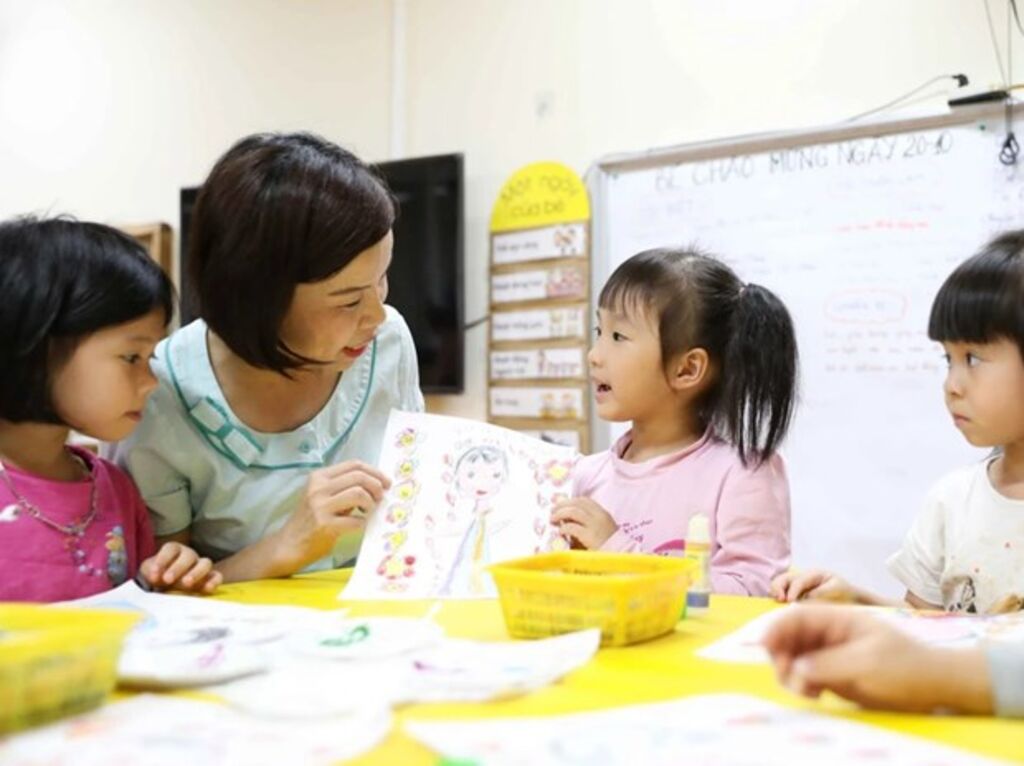 |
| Children learn drawing at a kindergarten in Hoan Kiem district, Hanoi__Photo: VNA |
Reforming mechanisms for mobilizing private organizations, businesses, individuals, and the society’s engagement in child care and protection is among the key tasks recently set by the Politburo.
This is part of the Politburo’s Directive 28-CT/TW, issued on December 25, 2023, on the enhancement of child care, education, and protection.
In November 2012, the Politburo also released a directive on promoting the Party’s leadership over child care, education, and protection which affirmed the need to boost the private sector’s engagement in the work.
Since then, much progress has been seen in the attraction of private parties to child care and protection, the Ministry of Labor, Invalids and Social Affairs (MoLISA) said, elaborating that families and the society’s awareness of the issue has been increasingly improved as seen in higher rates of birth registration and children covered by health insurance.
The mobilization of private resources for education has also been stepped up while curricular and extracurricular activities reformed to include contents related to child care and protection such as life skills, HIV/AIDS prevention, and childhood accident prevention.
Authorities, the community, and children themselves have also become more aware of the importance of child care and protection and further involved in the work, which has seen active performance by the Vietnam Fatherland Front, Youth Union, Women’s Union, and Farmers’ Union, and Vietnam Association for the Protection of Child Rights, as well as domestic and international non-governmental organizations, according to MoLISA.
MA Pham Thi Hai from MoLISA held that to promote the private sector’s engagement, the State should establish a legal framework on child protection, including the mobilization of private parties’ participation; regulate the rights and responsibilities of individuals, organizations, and the community when they supply child care and protection services; and stipulate people’s rights to benefit from those services.
In addition, the State needs to devise mechanisms and policies on training civil servants and volunteers in the field, create a favorable environment for child care and protection along with the supply of children-related products, and fulfill its role in supervision, inspection, and settlement of law violations, she noted.
Hai added that though engaging the private sector’s participation is meant to maximise resources for child care and protection, investment from the State still holds the main role, particularly in remote areas and at the grassroots level, where it is difficult for private investors to gain benefits or profit from.
The state budget’s spending on education and health care for children has been rising over years, statistics show.
During 2013 - 2023, education accounts for 17.8 percent of the state budget’s total annual spending. Of the spending on education, 20 percent is for pre-school education, 32 percent for primary education, 25 percent for junior high school education, and 12 percent for senior high school education.
As a result, impressive achievements have been harvested, including the rates of literate school-age people and children enrolling in compulsory preschool education at 96.8 percent and 98.3 percent, respectively. Vietnam also ranks 59th in the global education rankings.
Meanwhile, considerable funding has also been allocated for health care, the Ministry of Finance said, noting that the state budget’s total funding for the health sector tops 38.13 trillion VND (1.5 billion USD) for the 2021 - 2025 period, excluding the spending integrated into the national target programs.
A number of health programs and projects for children have been carried out such as buying health insurance for under-six children, the expanded vaccination program, and the ones on food safety, population, and HIV/AIDS control.
Deputy Minister of Health Tran Van Thuan said mother and child indexes in Vietnam are relatively goods compared to many other countries with equivalent per capita income.
During 2020 - 2022, the under-five mortality rate was brought down to 18.9 per thousand from 39.6 per thousand while the under-one mortality rate also fell by over two times to 12.1 per thousand from 29.5 per thousand. The rate of fully vaccinated children under one year of age has also been maintained at over 90 percent.
A recent nutrition census indicated that the rate of under-five children with stunting has also declined gradually, from 29.3 percent in 2010 to under 18.9 percent in 2022.- (VNA/VLLF)









